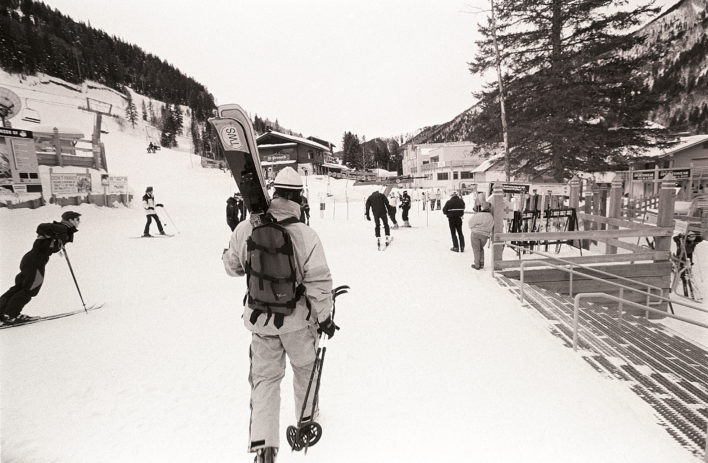
Jibbing was hot as hellfire when Eric Blehm became editor of Transworld Snowboarding in 1995. Most snowboard media focused heavily on freestyle, but Blehm was more fascinated by the Nitro Tour than the glut of twins that graced the 501 pages of the magazine’s 1995 gear guide.
Blehm’s tenure at Transworld stretched through 1998, a period during which he fought hard to shine the spotlight on backcountry boarding. “I loved to include a backcountry feature, or at least an adventure-based article, in every issue,” he says. He nixed photos of backcountry riders without backpacks since it suggested they weren’t carrying avalanche gear, and the Transworld staff subsequently nicknamed him “Backpack Blehm.” It was both an insult and a badge of honor.
Blehm took off-piste protocol seriously, penning several stories on avalanche safety for Transworld. “I was always pushing to keep the magazine real for the everyday rider who just wants to freeride,” he says. He wrote a hard-hitting story on snowboard incidents in the backcountry in 1995. That same year, he attended a seven-day avalanche boot camp in pursuit of his Canadian Avalanche Association Level One certification, which he covered in a 1996 issue. Both articles alerted freeriders to the dangers of following a bootpack beyond resort boundaries. But his most impactful work was arguably a satirical series for the magazine on “the Chameleon,” a covert, unidentified splitboarder who camouflages himself as a skier to infiltrate resorts that didn’t allow snowboarders.
In a 1995 article “Live and Let It Ride,” Blehm put out a call for a special agent, specifically a “007-type who could snowboard.” Blehm writes, “We took out a classified ad in Spy Magazine and another in Soldier of Fortune, reading: ‘Wanted: spy specializing in reconnaissance skills, enemy evasion, driving in snowy-mountainous terrain and snowboarding.’” Candidates were to send resumes to Transworld’s Oceanside, Calif. office. Blehm describes the operative’s equipment as such: “We had already ordered a special snowboard for the mission and shipped it to Salty Peaks Snowboard Shop in Salt Lake City. The board, made by Nitro, splits into two separate skis for backcountry travel, but it would work nicely for upward mobility on chairlifts at places like Alta. Since no tools are required to change the board from skis into board, it was a perfect disguise element for the Chameleon. Ride up the lift as a skier, duck into trees and emerge as a snowboarder. It seemed so simple….”
Soon after, the position was filled and the Chameleon targeted Alta, Utah, and Keystone and Aspen, Colorado, in 1995; Park City, Utah, in 1996; and Taos, New Mexico, in 1997. Accompanied by photos of operatives, their faces blurred, charging hard and beefing with tightwad ski patrollers, the series did more than elicit chuckles from Transworld’s readers. “It was the first time that I had seen splitboarding in a magazine,” says professional rider Jeremy Jones. “That was my introduction to splitboarding.”
After three years as editor, Blehm left Transworld, but he continued to freelance for snowboard magazines. He featured Craig Kelly, Tom Burt and John Buffery in Snowboard Life and represented splitboarders in the pages of Couloir, including a feature about joining Jim Zellers and Tom Burt on a grueling midwinter traverse across the Sierra Nevada in 2002, likely a splitboard first, which helped validate the sport in the eyes of hardcore backcountry users. Publications like Couloir, Snowboard Life, Backcountry and The Snowboarder’s Journal all gave coveted space to splitboarding in the sport’s adolescence. Kronicle, a backcountry snowboarding magazine and sister publication to Backcountry, even launched in 2011, although it only held on for two seasons. But in the ’90s, Transworld was the ultimate stage for such a young sport.
After 32 years, Transworld folded in 2019. In a farewell letter to the magazine, Blehm wrote, “If there is one thing I’m most proud of from my era at the magazine, it’s instilling the importance of avalanche awareness and safety to our readers.” While he handled those heavy topics with grace, no piece tickled him more than the lighthearted debut of the Chameleon. “It was probably my favorite story to sit down and write,” says Blehm of “Live and Let It Ride.” “I felt like it was me versus the evil elitist ski resorts.”
In a sense, it was: As many have guessed over the years, Blehm was the Chameleon all along.
A nomad who lives to chase snow and surf, Drew Zieff spent his first winter in Utah’s Wasatch Mountains this past year. After Covid-19 put the kibosh on his touring season—and travel in general—Zieff hunkered down at his desk for months and cobbled together a mammoth story on the history and future of splitboarding from which this piece was pulled. To read the full feature, pick up a copy of Issue #136 or subscribe.










Honored to see this story! Thank you!
Does anyone know where to find the original chameleon articles? I remember reading the Taos one as a kid and loved it.
Phillip. They ran in TransWorld SNOWboarding in the mid to late 1990s. I’m actually planning on transcribing them, and might put them up on my website sometime in the next few months. http://www.ericblehm.com … if you follow me on Insta, I’m sure I’ll announce it there. You’re not the first to go hunting for them. —Eric Blehm